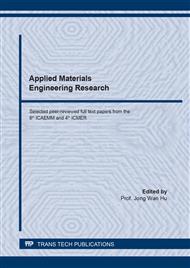p.1
p.9
p.15
p.23
p.29
p.39
p.45
p.59
Influence of Creep on Longitudinal Fracture of Inhomogeneous Rod Loaded in Torsion and Bending
Abstract:
The present paper analyzes the influence of creep on longitudinal fracture in continuously inhomogeneous rod of circular cross-section loaded in torsion and bending. The rod exhibits continuous material inhomogeneity in both radial and longitudinal directions. The creep is described by using non-linear time-dependent relations between the principle stresses and strains. A time-dependent solution to the strain energy release rate is derived by analyzing the complementary strain energy. The time-dependent strain energy release rate is found also by considering the energy balance for verification. The solutions are applied to perform a parametric study of the strain energy release rate under creep.
Info:
Periodical:
Pages:
9-14
Citation:
Online since:
September 2021
Authors:
Keywords:
Price:
Сopyright:
© 2021 Trans Tech Publications Ltd. All Rights Reserved
Share:
Citation:


